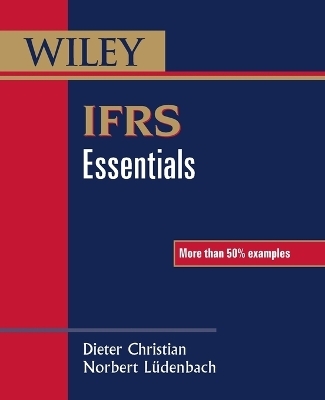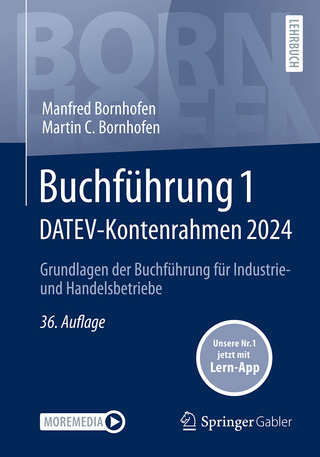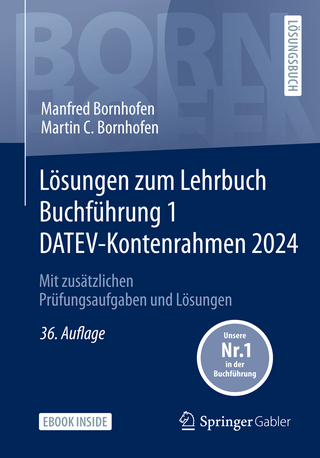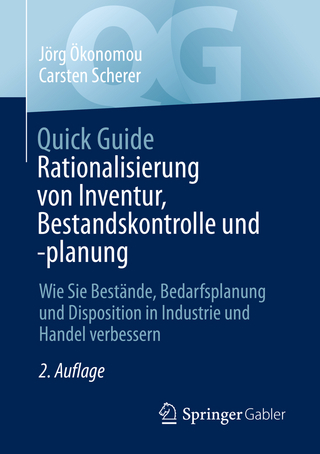
IFRS Essentials
John Wiley & Sons Inc (Verlag)
978-1-118-49471-4 (ISBN)
Gain a deeper understanding of financial reporting under IFRS through clear explanations and extensive practical examples.
IFRS can be a complex topic, and books on the subject often tackle its intricacies through dense explanation across thousands of pages. Others seek to provide an overview of IFRS and these, while useful for the general reader, lack the depth required by practitioners and students.
IFRS Essentials strikes a balance between the two extremes, offering concise interpretation of the crucial facts supported by a wealth of examples. Problems and their solutions are demonstrated in a manner which is short, straightforward and simple to understand, avoiding complex language; jargon and redundant detail.
This book is suitable for students and lecturers at universities and other educational institutions, auditing and accounting trainees, and employees in the area of accounting and auditing who seek to develop their practical skills and deepen their knowledge of IFRS.
Dr. Dieter Christian is a lecturer at the Vienna University of Economics and Business, several other Austrian universities and various private seminar companies. He is an author in the area of IFRS and Austrian GAAP. He was formerly a Senior Manager and head of the department for IFRS and Austrian GAAP at BDO Austria and also worked in the IFRS department for PricewaterhouseCoopers in Austria. He has a Doctorate in Business Administration and an MBA from Vienna University of Economics and Business. He is a Member of the IFRS working group of the Austrian Financial Reporting and Auditing Committee (AFRAC). Dr. Norbert Lüdenbach is a tax advisor and chartered accountant, and is Head of the IFRS Department of BDO Germany. He is an author of commentaries on IFRS and German GAAP as well as being a lecturer at the University of Freiburg (Germany). He is also the publisher of a practice-oriented German IFRS journal which is published on a monthly basis.
Preface xvii
Abbreviations xix
The Conceptual Framework for Financial Reporting 1
1 Introduction 1
2 The Objective of General Purpose Financial Reporting 1
3 Going Concern 2
4 Qualitative Characteristics of Useful Financial Information 2
4.1 Introduction 2
4.2 Fundamental Qualitative Characteristics 2
4.2.1 Relevance 3
4.2.2 FaithfulRepresentation 3
4.3 Enhancing Qualitative Characteristics 4
4.3.1 Comparability 5
4.3.2 Verifiability 5
4.3.3 Timeliness 5
4.3.4 Understandability 5
5 The Cost Constraint on Useful Financial Reporting 5
6 The Elements of Financial Statements 6
6.1 Definitions 6
6.2 Recognition 6
6.3 Measurement 7
7 Exampleswith Solutions 7
IAS 1 Presentation of Financial Statements 11
1 Introduction and Scope 11
2 Going Concern 11
3 Fair Presentation of the Financial Statements and Compliance with IFRSs 11
4 General Principles Relating to Presentation 12
4.1 Materiality and Aggregation 12
4.2 Offsetting 12
4.3 Frequency of Reporting 12
4.4 Comparative Information 12
4.5 Consistency of Presentation 13
5 Components of the Financial Statements 13
6 Structure and Content of the Components of the Financial Statements 13
6.1 Statement of Financial Position (Balance Sheet) 13
6.2 Statement of Comprehensive Income and Separate Income Statement 14
6.2.1 Profit or Loss, Other Comprehensive Income and How They Interrelate 14
6.2.2 Preparation of the Statement(s) 16
6.3 Statement of Changes in Equity 19
7 Exampleswith Solutions 20
7.1 Examples that can be Solved Without the Knowledge of Other Chapters of theBook 21
7.2 Examples that Require Knowledge of Other Sections of the Book 25
IAS 2 Inventories 33
1 Scope 33
2 Measurement 33
2.1 Measurement at Recognition 33
2.2 Measurement after Recognition 34
3 Presentation and Derecognition 35
4 Exampleswith Solutions 35
IAS 7 Statement ofCash Flows 43
1 Introduction 43
2 Preparation of the Statement of Cash Flows 44
2.1 Operating Activities 44
2.2 Investing and Financing Activities 44
3 Special Topics 45
3.1 Interest and Dividends 45
3.2 Income Taxes 45
4 Consolidated Statements ofCash Flows 45
4.1 Introduction 45
4.2 Acquisitions and Disposals of Subsidiaries 46
4.3 Associates 46
5 Exampleswith Solutions 46
IAS 8 Accounting Policies, Changes in Accounting Estimates, and Errors 55
1 Introduction 55
2 Accounting Policies 55
2.1 Selection and Application of Accounting Policies 55
2.2 The Principle ofConsistency 56
2.3 When an Accounting Policy Has to be Changed 57
2.4 Consequences of a Change in Accounting Policy 57
3 Changes in Accounting Estimates 57
3.1 Introduction 57
3.2 Accounting Treatment 58
4 Correction of Prior Period Errors 58
5 Exampleswith Solutions 59
IAS 10 Events after the Reporting Period 71
1 Overview 71
2 Exampleswith Solutions 72
IAS 11 Construction Contracts 75
1 Introduction 75
2 Contract Revenue 75
3 ContractCosts 76
4 Percentage of Completion Method 76
4.1 Introduction 76
4.2 Reliable Estimate of the Outcome of a Contract 77
4.3 Determining the Stage ofCompletion 77
4.4 Recognition of Expected Losses 78
4.5 Uncertainties in Collectibility 78
4.6 Presentation andDisclosure 78
5 When the Outcome of a Contract Cannot be Estimated Reliably 79
6 Exampleswith Solutions 79
IAS 12 Income Taxes 91
1 Introduction 91
2 Current Tax 91
3 Deferred Tax 91
3.1 The Logic Behind Recognizing Deferred Tax 91
3.2 Recognition Criteria 93
3.2.1 Taxable Temporary Differences 93
3.2.2 Deductible Temporary Differences 93
3.2.3 Unused Tax Losses andUnused TaxCredits 94
3.2.4 Reassessment of Unrecognized Deferred Tax Assets 94
3.2.5 Outside Basis Differences vs Inside Basis Differences 94
3.3 Measurement 94
3.3.1 Applicable Tax Rates and Tax Laws 94
3.3.2 Manner of Recovery or Settlement of the Carrying Amount of an Asset or a Liability 95
3.3.3 Prohibition of Discounting 95
3.3.4 Impairment and Reversal of Impairment 95
3.4 Presentation 95
3.5 Specific Issues 96
3.5.1 Change in the Tax Rate 96
3.5.2 BusinessCombinations 96
4 Tax (or Tax Rate) Reconciliation 96
5 Exampleswith solutions 97
IAS 16 Property, Plant, and Equipment 111
1 Introduction 111
2 Recognition 111
3 Measurement at Recognition 112
4 Measurement after Recognition 113
4.1 Cost Model and Revaluation Model 113
4.2 Depreciation 113
4.2.1 Depreciable Amount 113
4.2.2 Depreciation Period 114
4.2.3 DepreciationMethod 114
4.2.4 Component Accounting 115
4.3 Impairment 115
4.4 Changes in Existing Decommissioning, Restoration, and Similar Liabilities 115
5 Derecognition 116
6 Exampleswith solutions 116
IAS 17Leases 127
1 Introduction and Scope 127
2 DefinitionsRelating to Time 127
3 Classification of Leases as Finance Leases or Operating Leases 127
3.1 Introduction 127
3.2 Primary LeaseClassificationCriteria 128
3.3 Supplemental Indicators of a Finance Lease 129
4 Accounting of Leases by Lessees 130
4.1 Finance Leases 130
4.2 Operating Leases 130
5 Accounting of Leases by Lessors 131
5.1 Finance Leases 131
5.2 Operating Leases 131
6 Sale and Leaseback Transactions 132
7 Exampleswith Solutions 132
IAS 18 Revenue 143
1 Introduction and Scope 143
2 Measurement of Revenue 143
3 Sale of Goods 144
4 Rendering of Services 145
5 Interest, Royalties, and Dividends 145
6 Multiple Element Transactions and Linked Transactions 146
6.1 Introduction 146
6.2 Multiple Element Transactions 146
6.2.1 Sale onCredit 146
6.2.2 Servicing Component 147
6.2.3 Customer Loyalty Programs 147
6.3 Linked Transactions 148
7 Exampleswith solutions 148
IAS 19 Employee Benefits and IAS 26 Accounting and Reporting by Retirement Benefit Plans 155
1 Introduction 155
2 Financial Reporting without Early Application of the Amendments to IAS 19 Issued in June 2011 155
2.1 Introduction and Scope 155
2.2 Short-term Employee Benefits 156
2.3 Post-employment Benefits 156
2.3.1 Introduction 156
2.3.2 Defined Contribution Plans 157
2.3.3 Defined Benefit Plans 157
2.4 Other Long-term Employee Benefits 160
2.5 Termination Benefits 160
2.6 Exampleswith Solutions 161
3 The Amendments to IAS 19 Issued in June 2011 169
3.1 Post-employment Benefits 170
3.2 Termination Benefits 171
3.2.1 Recognition 171
3.2.2 Measurement 172
IAS 20 Government Grants 173
1 Introduction and Scope 173
2 Recognition and Measurement 173
3 Presentation 174
3.1 GrantsRelated toAssets 174
3.2 Grants Related to Income 174
4 Repayment of Government Grants 175
5 Exampleswith Solutions 175
IAS 21 The Effects of Changes in Foreign Exchange Rates 183
1 Scope 183
2 Monetary vs non-Monetary Items 183
3 Translation of Foreign Currency Transactions 184
3.1 Initial Recognition 184
3.2 Subsequent Reporting – Monetary Items 184
3.3 Subsequent Reporting – Non-monetary Items 184
4 Translation of Financial Statements of Foreign Operations When Preparing the Consolidated Financial Statements 185
4.1 Determining the Functional Currency and the Method of Foreign Currency Translation 185
4.2 CurrentRate (orClosingRate)Method 186
4.3 Monetary/Non-monetary Method 187
5 Exampleswith Solutions 188
IAS 23BorrowingCosts 197
1 Introduction 197
2 Specific and General Borrowings 197
3 Period ofCapitalization 198
4 Exampleswith Solutions 199
IAS 24Related PartyDisclosures 203
1 Introduction 203
2 Related Parties andRelationshipswith Them 203
3 Disclosures 204
4 Application of IAS 24 in the Consolidated Financial Statements 205
5 Exampleswith Solutions 205
IAS 26 Accounting and Reporting by Retirement Benefit Plans: see the Chapter on IAS 19/IAS 26 209
IAS 27 (2008) Consolidated and Separate Financial Statements, IAS 27 (2011) Separate Financial Statements, and IFRS 10 (2011) Consolidated Financial Statements 211
1 Introduction 211
2 Financial Reporting without Early Application of IFRS 10 and IAS 27 (2011) 212
2.1 The Concept of “Control” 212
2.2 Balance Sheet Date of the Consolidated Financial Statements and Diverging Balance Sheet Dates of Subsidiaries 213
2.3 Preparing the Consolidated Financial Statements 213
2.3.1 Overview 213
2.3.2 Elimination of Intragroup Receivables and Liabilities 214
2.3.3 Elimination of Intragroup Income and Expenses 215
2.3.4 Elimination of Intragroup Profits and Losses that are Recognized in the Carrying Amounts of Assets 215
2.3.5 Non-controlling Interests 215
2.4 Acquisition and Disposal of Shares 216
2.5 Investments in Subsidiaries, Jointly Controlled Entities, and Associates in Separate Financial Statements 217
2.6 Exampleswith Solutions 218
3 IFRS 10 (Issued in May 2011) 228
3.1 Introduction 228
3.2 AssessingControl 228
3.2.1 Overview 228
3.2.2 Power 229
3.2.3 Exposure or Rights to Variable Returns 231
3.2.4 LinkBetween Power andReturns 231
3.2.5 Conclusion 232
3.3 Examplewith Solution 232
4 The New Version of IAS 27 (Issued in May 2011) 233
IAS 28 Investments in Associates and IAS 28 (2011) Investments in Associates and JointVentures 235
1 Introduction 235
2 Financial Reporting without Early Application of the Amendments to IAS 28 Issued in May 2011 235
2.1 The Term “Associate” and Scope of IAS 28 235
2.2 The EquityMethod 236
2.2.1 Overview 236
2.2.2 Impairment Losses and Reversals of Impairment Losses 238
2.2.3 Uniform Accounting Policies 238
2.2.4 Elimination of Intragroup Profits and Losses 239
2.2.5 Continuing Losses 239
2.2.6 Balance Sheet Date of the Financial Statements of the Associate 239
2.2.7 Application of the Concept of Materiality 239
2.3 Presentation 240
2.4 Separate Financial Statements of the Investor 240
2.5 Preparation of the Consolidated Financial Statements 240
2.6 Exampleswith Solutions 241
3 The Amendments to IAS 28 Issued in May 2011 252
IAS 29 Financial Reporting in Hyperinflationary Economies 253
1 Introduction 253
2 Application of IAS 29 Relating to Foreign Operations: the “7-Step-Approach” 253
3 Reporting Period in Which an Entity Identifies Hyperinflation when the Currency was not Hyperinflationary in the Prior Period 254
4 Examplewith Solution 255
IAS 31 Interests in Joint Ventures and IFRS 11 Joint Arrangements 261
1 Introduction 261
2 IAS 31 “Interests in JointVentures” 261
2.1 The Term“JointVenture” and Forms of JointVentures 261
2.2 Accounting Treatment in the Financial Statements of the Venturer 262
2.2.1 Jointly Controlled Operations in Consolidated and Separate Financial Statements 262
2.2.2 Jointly Controlled Assets in Consolidated and Separate Financial Statements 262
2.2.3 Jointly Controlled Entities 262
2.3 Examplewith Solution 263
3 IFRS 11 “Joint Arrangements” (Issued in May 2011) 265
3.1 Introduction 265
3.2 Assessing JointControl 266
3.3 Types of Joint Arrangement 267
3.3.1 Introduction 267
3.3.2 Structure of the Joint Arrangement 267
3.4 Consolidated Financial Statements of Parties to a Joint Arrangement 268
3.4.1 JointOperations 269
3.4.2 JointVentures 269
3.5 Separate Financial Statements of Parties to a Joint Arrangement 269
3.5.1 JointOperations 270
3.5.2 JointVentures 270
3.6 Examplewith Solution 270
IAS 32 Financial Instruments: Presentation 273
1 The Term “Financial Instrument” 273
2 Scope 274
3 Differentiation Between Equity and Liabilities 274
4 Accounting for a Convertible Bond after Recognition by the Issuer 275
5 Treasury Shares 275
6 Costs of an Equity Transaction 276
7 Offsetting 277
8 Exampleswith Solutions 277
IAS 33 Earnings per Share 283
1 Introduction and Scope 283
2 Ordinary Shares and Potential Ordinary Shares 283
3 Basic Earnings per Share 283
4 Diluted Earnings per Share 284
5 Presentation andDisclosure 285
6 Exampleswith Solutions 285
IAS 34 Interim Financial Reporting 293
1 Introduction 293
2 Content of an Interim Financial Report 293
2.1 Components 293
2.2 Periods and Dates to be Presented in Interim Reports 294
3 Materiality 294
4 Recognition and Measurement 294
4.1 Discrete Approach vs Integral Approach 294
4.2 Independence of the Annual Result from the Frequency of Reporting 295
4.3 Quantity Component and Price Component 295
5 Exampleswith Solutions 296
IAS 36 Impairment ofAssets 301
1 Introduction and Scope of IAS 36 301
2 When to Test for Impairment 301
3 When toReverse an Impairment Loss 302
4 Determining the Recoverable Amount for an Individual Asset or for an Asset’s CGU? 302
5 Determining the Recoverable Amount 303
5.1 General Aspects 303
5.2 FairValue LessCosts to Sell 304
5.3 Value inUse 304
5.3.1 Introduction 304
5.3.2 Estimating the FutureCash Flows 305
5.3.3 Determining the Discount Rate 306
6 Determining the Carrying Amount of a CGU 307
7 Goodwill 307
7.1 Allocating Goodwill to CGUs 307
7.2 Multi-level Impairment Test 307
8 CorporateAssets 308
9 Recognizing and Reversing an Impairment Loss 308
10 Non-controlling Interests 309
11 Exampleswith Solutions 310
IAS 37 Provisions, Contingent Liabilities, and Contingent Assets 325
1 Scope 325
2 Definition and Recognition of Provisions 325
2.1 Overview 325
2.2 Existence of a Present Obligation 325
2.3 Past Event 326
2.4 Probability of an Outflow of Resources 326
2.5 Reliable Estimate of the Amount of the Obligation 327
2.6 Distinction from Other Liabilities 327
3 Contingent Liabilities 327
4 Contingent Assets 327
5 Measurement 328
6 Reimbursements 328
7 Changes in Provisions 329
8 Specific Issues 329
8.1 OnerousContracts 329
8.2 Provisions for Decommissioning, Restoration, and Similar Obligations 329
8.3 Restructurings 330
8.4 Decommissioning Funds 331
9 Exampleswith solutions 331
IAS 38 Intangible Assets 337
1 Scope of IAS 38 337
2 The Term “Intangible Asset” 337
3 Recognition and Initial Measurement 338
3.1 Introduction 338
3.2 Separate Acquisition of Intangible Assets 338
3.3 Acquisition of Intangible Assets as Part of a Business Combination 338
3.4 Internally Generated Intangible Assets 339
4 Further Prohibitions ofCapitalization 341
5 Measurement after Recognition 341
5.1 Cost Model and Revaluation Model 341
5.2 Intangible Assets With Finite Useful Lives 342
5.3 Intangible Assets With Indefinite Useful Lives 343
5.4 Impairment 343
6 Derecognition 344
7 Exampleswith Solutions 344
IAS 39 Financial Instruments: Recognition and Measurement: see the Chapter on IFRS 9/IAS 39 351
IAS 40 Investment Property 353
1 The Concept of “Investment Property” 353
2 Recognition 354
3 Measurement at Recognition 354
4 Measurement after Recognition 354
4.1 Introduction 354
4.2 Fair Value Model 355
4.3 Cost Model 356
5 Derecognition 356
6 Presentation 357
7 Exampleswith solutions 357
IAS 41Agriculture 365
1 Introduction and Scope 365
2 Recognition 365
3 Measurement 365
4 GovernmentGrants 366
5 Exampleswith Solutions 367
IFRS 1 First-time Adoption of International Financial Reporting Standards 371
1 Introduction and Scope 371
2 Recognition and Measurement 372
2.1 Accounting Policies 372
2.2 Exceptions to Retrospective Application of Other IFRSs (Mandatory) 373
2.3 Exemptions from Other IFRSs (Optional) 373
2.3.1 Overview 373
2.3.2 Measurement of Property, Plant, and Equipment 373
2.3.3 ForeignCurrencyReserve 374
2.3.4 BusinessCombinations 374
2.4 Deferred Tax 374
3 Presentation andDisclosure 375
4 Exampleswith Solutions 375
IFRS 2 Share-based Payment 379
1 A general introduction to Employee Share Options 379
2 Scope of IFRS 2 380
3 The Accounting of Employee Share Options 380
3.1 Introduction 380
3.2 Equity-settled Transactions 381
3.3 Cash-settled Transactions 382
4 Exampleswith Solutions 383
IFRS 3BusinessCombinations 389
1 Introduction and Scope 389
2 Acquisition of Shares vs Acquisition of the Individual Assets 389
3 Identifying the Acquirer 390
4 Acquisition Date 390
5 Acquisition-related Costs 390
6 Accounting for a Business Combination on the Acquisition Date 390
6.1 Overview 390
6.2 Identifiable Assets Acquired and Liabilities Assumed 391
6.2.1 Recognition in the Statement of Financial Position 391
6.2.2 Classifications andDesignations 392
6.2.3 Measurement 392
6.2.4 Exception to the Recognition Rules 393
6.2.5 Exceptions to the Recognition and Measurement Rules 393
6.2.6 Exception to the Measurement Rules 393
6.3 Non-controlling Interest 393
6.4 Goodwill and Gain on a Bargain Purchase 394
6.5 Business Combination Achieved in Stages 394
6.6 Consideration Transferred (Including Contingent Consideration) 395
6.7 Measurement Period 396
7 Subsequent Measurement and Accounting 397
8 Deferred tax 398
9 Entries Necessary in Order to Prepare the Consolidated Financial Statements 398
10 DeterminingWhat is Part of theBusinessCombination Transaction 399
11 Exampleswith Solutions 400
IFRS 4 Insurance Contracts 421
1 Introduction and Scope 421
2 Insurance Contracts, Insurance Risk, and the Scope of IFRS 4 421
3 Financial Reporting for Insurance Contracts 421
4 Examplewith Solution 422
IFRS 5 Non-current Assets Held for Sale and Discontinued Operations 425
1 Introduction and Overview 425
2 Scope 426
3 Non-current Assets and Disposal Groups held for Sale 426
3.1 Classification as “Held for Sale” 426
3.2 Measurement of Non-current Assets and Disposal Groups Classified as “Held for Sale” 428
3.2.1 General Aspects 428
3.2.2 Changes to a Plan of Sale 429
3.3 Presentation 429
4 Presentation of Discontinued Operations 430
4.1 General Aspects 430
4.2 Selected Specifics in Consolidated Financial Statements 431
5 Exampleswith Solutions 431
IFRS 6 Exploration for and Evaluation of Mineral Resources 441
1 Introduction and Scope 441
2 Financial Reporting 441
3 Stripping Costs in the Production Phase of a Surface Mine 442
4 Examplewith Solution 443
IFRS 7 Financial Instruments: Disclosures 445
1 Introduction 445
2 Significance of Financial Instruments for Financial Position and Performance 445
3 Nature and Extent of Risks Arising from Financial Instruments 446
4 Transfers of Financial Assets 447
5 Exampleswith Solutions 447
IFRS 8 Operating Segments 451
1 Introduction 451
2 Scope 451
3 Operating Segments andChiefOperatingDecisionMaker 451
4 Reportable Segments 452
4.1 Overview 452
4.2 Aggregation ofOperating Segments 453
4.3 Quantitative Thresholds 453
4.4 RemainingOperating Segments 453
5 SegmentDisclosures 454
5.1 Determination of the Amounts to be Disclosed 454
5.2 Disclosure Requirements 454
5.2.1 Segment Profit or Loss 454
5.2.2 Segment Assets and Segment Liabilities 455
5.2.3 Reconciliations 455
5.2.4 OtherDisclosures 456
6 Entity-wide Disclosures 456
7 Exampleswith Solutions 457
IFRS 9 Financial Instruments and IAS 39 Financial Instruments: Recognition andMeasurement 461
1 Introduction 461
2 Financial Instruments Accounting According to IFRS 9 (as Issued in 2010) and its Consequential Amendments to IAS 39 462
2.1 Scope 462
2.2 Initial Recognition 462
2.3 Measurement 462
2.3.1 Derivatives and Financial Instruments Held for Trading 462
2.3.2 Initial Measurement 463
2.3.3 Subsequent Measurement of Financial Assets 463
2.3.4 Subsequent Measurement of Financial Liabilities 465
2.3.5 Measurement at Amortized Cost: Determining the Effective InterestRate 465
2.3.6 Determining Fair Values After Recognition 466
2.3.7 Presentation of FairValueGains and Losses 466
2.3.8 Impairment Losses and Reversals of Impairment Losses 467
2.4 HybridContracts 468
2.4.1 Introduction 468
2.4.2 Hybrid Contracts with Financial Asset Hosts 468
2.4.3 OtherHybridContracts 468
2.5 Derecognition of Financial Assets 469
2.6 Financial Guarantee Contracts From the Issuer’s Perspective 470
2.7 Hedge Accounting 471
2.7.1 Introduction 471
2.7.2 TheRules inMoreDetail 473
2.8 Exampleswith Solutions 475
3 Financial Instruments Accounting Prior to IFRS 9 495
3.1 Scope 495
3.2 Subsequent Measurement 495
3.2.1 Assigning a Financial Asset or a Financial Liability to a MeasurementCategory 495
3.2.2 Gains and Losses and Technical Aspects 497
3.2.3 Determining Fair Values After Recognition 497
3.2.4 Impairment Losses and Reversals of Impairment Losses 497
3.3 HybridContracts 499
3.4 Exampleswith Solutions 499
IFRS 10 Consolidated Financial Statements: see the Chapter on IAS 27/IFRS
10 503
IFRS 11 Joint Arrangements: see the Chapter on IAS 31/IFRS 11 505
IFRS 12Disclosure of Interests inOtherEntities 507
1 Introduction 507
2 The Term “Structured Entity” 507
3 The Individual Disclosure Requirements of IFRS 12 508
3.1 Significant Judgments and Assumptions 508
3.2 Interests in Subsidiaries 509
3.3 Interests in Joint Arrangements and Associates 510
3.4 Interests in Unconsolidated Structured Entities 511
4 Exampleswith Solutions 511
IFRS 13 FairValueMeasurement 513
1 Introduction 513
2 Scope 513
3 The Measurement Requirements of IFRS 13 514
3.1 Definition of Fair Value 514
3.2 The Asset or Liability 514
3.3 The Transaction 515
3.4 Market Participants 516
3.5 The Price 516
3.6 Application to Non-financial Assets 517
3.7 Application to Liabilities and the Entity’s Own Equity Instruments 517
3.8 Fair Value at Initial Recognition 518
3.9 Valuation Techniques 518
3.10 Inputs to Valuation Techniques 519
3.11 FairValueHierarchy 519
3.11.1 Level 1 Inputs 520
3.11.2 Level 2 Inputs 520
3.11.3 Level 3 Inputs 520
4 Illustration of the Application of Selected Valuation Techniques 521
4.1 Measuring Owner-occupied Items of Property, Plant, and Equipment 521
4.2 Measuring American Options According to the Binomial Model 521
4.3 Measuring a Brand According to the Relief from Royalty Method 521
4.4 The Tax Amortization Benefit 522
5 Exampleswith Solutions 522
Index 527
| Erscheint lt. Verlag | 4.4.2013 |
|---|---|
| Reihe/Serie | Wiley Regulatory Reporting ; 1 |
| Verlagsort | New York |
| Sprache | englisch |
| Maße | 188 x 234 mm |
| Gewicht | 1039 g |
| Themenwelt | Wirtschaft ► Betriebswirtschaft / Management ► Rechnungswesen / Bilanzen |
| ISBN-10 | 1-118-49471-7 / 1118494717 |
| ISBN-13 | 978-1-118-49471-4 / 9781118494714 |
| Zustand | Neuware |
| Informationen gemäß Produktsicherheitsverordnung (GPSR) | |
| Haben Sie eine Frage zum Produkt? |
aus dem Bereich


